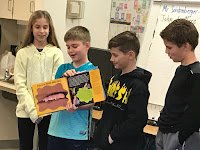More and more, our students are having to deal with adult sized feelings and emotions. Divorce, over-scheduling, seeing too much too soon, and a host of other issues have contributed to our younger students trying to learn with less than ideal emotions. What can educators do? Don't we already have enough on our plates? We have always taught reading, writing, math, science, and social studies. In recent years character education, drug and alcohol awareness, nutrition, and personal safety have been added to our ever-increasing load. How can we even consider adding one more thing? What can we do about their emotional well-being? Isn't being nurturing enough?
I understand the push back and the concerns about time. However, what if the students' emotional well-being is what everything else is placed upon? If our students are not in a learning zone, does it really mean anything if we cover all the assigned curriculum? Will the students have any chance of learning it?
Dealing with an ever-increasing incidence of student anxiety, fears, and lack of emotional self-control has sent me searching for answers. Something new I am trying (and really liking) this year is Zones of Regulation.
LIFE IS 10% WHAT HAPPENS TO US AND 90% HOW WE REACT TO IT.
-CHARLES SWINDOLL
Students usually have little to no control over what happens to them. I certainly can't control what is causing them to feel emotionally on edge. Using the Zones of Regulation though we are beginning to identify which zone we are in. Once we identify our current zone, we can then take steps to move into the learning zone.
Per the program, there are four main zones:blue, yellow, red, and green.
The Blue Zone is one where one feels sick, sad, mopey, or down.
The Yellow Zone is more alert, but somewhat anxious, agitated, or silly.
The Red Zone is one of strong, extreme emotions such as rage or elation.
The Green Zone is where one is appropriately alert, calm, and receptive.
Neuroimaging and brain-based learning research has provided a scientific basis for not only the importance, but the absolute necessity, of adding student emotional control to our plates.
I contend that we must FIRST support our students' emotions and then, and only then, can we set to teaching the academics.
Students' stressors today are most likely to be caused by emotional feelings.Unfortunately our brain is unable to differentiate between the anxiety of a math test and the anxiety of being stalked by a tiger. This maladaptive response leads to a release of cortisol, aka the stress hormone. Chronic high cortisol levels can eventually destroy neurons associated with learning and memory. (Vincent 1990)
Helping our students move to a positive learning zone has to be a priority. That's why last week we discussed ways of calming down before a math test. We laughed about the fact that no one was ever killed by a math test and we did not need to prime our muscles, hearts, and lungs for flight. Instead we did some deep breathing, calmed our nerves, and got into the zone.
 |
| In 2, 3, 4...Out 2, 3, 4,5,6,7,8. |








